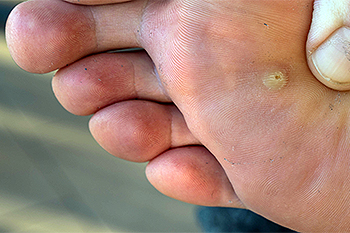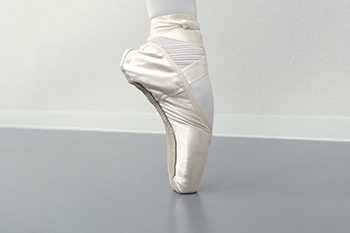Items filtered by date: September 2023
Get Proper Treatment for Ankle Injuries
Recognizing the Telltale Symptoms of Plantar Warts

Plantar warts are a common, but often misunderstood, skin condition that can be both uncomfortable and unsightly. These warts are caused by the human papillomavirus, abbreviated HPV, and specifically thrive on the soles of the feet, making them a unique challenge to deal with. Recognizing the symptoms is crucial for early detection and effective treatment. One of the hallmark signs of plantar warts is the appearance of small, grainy growths on the bottom of the foot. These warts may have tiny black dots, known as wart seeds within them, which are actually clotted blood vessels. Plantar warts can cause pain or discomfort, especially when pressure is applied, such as when walking or standing. These warts often have a tough, thickened layer of skin over them, making them appear flat against the foot's surface. They may also present with an irregular border and vary in color from flesh toned to brown or gray. It is essential to remember that plantar warts can sometimes be mistaken for other foot conditions, so if you suspect you have one, it is suggested that you consult a podiatrist for a proper diagnosis and appropriate treatment options.
Plantar warts can be very uncomfortable. If you need your feet checked, contact Scott Burdge, DPM from Advanced Ankle & Foot. Our doctor will assist you with all of your foot and ankle needs.
About Plantar Warts
Plantar warts are the result of HPV, or human papillomavirus, getting into open wounds on the feet. They are mostly found on the heels or balls of the feet.
While plantar warts are generally harmless, those experiencing excessive pain or those suffering from diabetes or a compromised immune system require immediate medical care. Plantar warts are easily diagnosed, usually through scraping off a bit of rough skin or by getting a biopsy.
Symptoms
- Lesions on the bottom of your feet, usually rough and grainy
- Hard or thick callused spots
- Wart seeds, which are small clotted blood vessels that look like little black spots
- Pain, discomfort, or tenderness of your feet when walking or standing
Treatment
- Freezing
- Electric tool removal
- Laser Treatment
- Topical Creams (prescription only)
- Over-the-counter medications
To help prevent developing plantar warts, avoid walking barefoot over abrasive surfaces that can cause cuts or wounds for HPV to get into. Avoiding direct contact with other warts, as well as not picking or rubbing existing warts, can help prevent the further spread of plantar warts. However, if you think you have developed plantar warts, speak to your podiatrist. He or she can diagnose the warts on your feet and recommend the appropriate treatment options.
If you have any questions please feel free to contact our office located in Katy, TX . We offer the newest diagnostic and treatment technologies for all your foot and ankle needs.
Enhancing Toe Point Through Foot Stretching

When it comes to dance, gymnastics, or even just maintaining healthy feet, having a well-pointed toe can make a significant difference. Achieving a beautifully pointed toe is not just about aesthetics, it is also about improving your overall foot flexibility and strength. Foot stretching is the key to unlocking this potential. Begin by sitting comfortably with your legs extended in front of you. Point your toes as far as possible and hold for a few seconds, feeling the stretch along the top of your feet. Next, flex your feet by pulling your toes towards you while keeping your heels on the ground. Repeat this cycle several times, gradually increasing the duration of each stretch. Another effective exercise involves using a resistance band. Sit with your legs extended, loop the band around your toes, and gently pull the band towards you. This will help improve the flexibility of your toes and the arches of your feet. It is beneficial to incorporate calf stretches into your routine, as flexible calf muscles can enhance your ability to point your toes effectively. Simple calf stretches can help maintain the alignment of your feet and ankles, supporting a graceful toe point. Consistency is important, and by regularly practicing foot stretches and exercises, you can steadily improve your toe point and enjoy the benefits of stronger and more flexible feet. If you would like more information about foot stretches that can strengthen the toes, it is suggested that you confer with a podiatrist.
Stretching the feet is a great way to prevent injuries. If you have any concerns with your feet consult with Scott Burdge, DPM from Advanced Ankle & Foot. Our doctor will assess your condition and provide you with quality foot and ankle treatment.
Stretching the Feet
Being the backbone of the body, the feet carry your entire weight and can easily become overexerted, causing cramps and pain. As with any body part, stretching your feet can serve many benefits. From increasing flexibility to even providing some pain relief, be sure to give your feet a stretch from time to time. This is especially important for athletes or anyone performing aerobic exercises, but anyone experiencing foot pain or is on their feet constantly should also engage in this practice.
Great ways to stretch your feet:
- Crossing one leg over the others and carefully pull your toes back. Do 10-20 repetitions and repeat the process for each foot
- Face a wall with your arms out and hands flat against the wall. Step back with one foot and keep it flat on the floor while moving the other leg forward. Lean towards the wall until you feel a stretch. Hold for 30 seconds and perform 10 repetitions for each foot
- Be sure not to overextend or push your limbs too hard or you could risk pulling or straining your muscle
Individuals who tend to their feet by regular stretching every day should be able to minimize foot pain and prevent new problems from arising.
If you have any questions, please feel free to contact our office located in Katy, TX . We offer the newest diagnostic and treatment technologies for all your foot care needs.
Treatment and Recovery for a Broken Ankle

A broken ankle is a distressing injury that can occur from accidents or sudden trauma. There are three bones that make up the ankle joint, the tibia, fibula, and talus. One or more of these bones can become fractured, and often demands immediate medical attention. This is necessary to assess the severity and type of fracture, which can range from stable to complex. The treatment varies and can involve immobilization with a cast or splint, and sometimes surgical intervention with the insertion of pins or plates to realign the bones. Recovery times depend on the fracture's complexity and the chosen treatment. Generally, mild fractures may heal in six to eight weeks, while more severe injuries may take several months. Patience and adherence to medical advice are key during recovery, ensuring a return to normal activities with a healed and stable ankle. If you have fractured your ankle, it is suggested that you confer with a podiatrist who can determine what the best course of treatment is for you.
Broken ankles need immediate treatment. If you are seeking treatment, contact Scott Burdge, DPM from Advanced Ankle & Foot. Our doctor can provide the care you need to keep you pain-free and on your feet.
Broken Ankles
A broken ankle is experienced when a person fractures their tibia or fibula in the lower leg and ankle area. Both of these bones are attached at the bottom of the leg and combine to form what we know to be our ankle.
When a physician is referring to a break of the ankle, he or she is usually referring to a break in the area where the tibia and fibula are joined to create our ankle joint. Ankles are more prone to fractures because the ankle is an area that suffers a lot of pressure and stress. There are some obvious signs when a person experiences a fractured ankle, and the following symptoms may be present.
Symptoms of a Fractured Ankle
- Excessive pain when the area is touched or when any pressure is placed on the ankle
- Swelling around the area
- Bruising of the area
- Area appears to be deformed
If you suspect an ankle fracture, it is recommended to seek treatment as soon as possible. The sooner you have your podiatrist diagnose the fracture, the quicker you’ll be on the way towards recovery.
If you have any questions, please feel free to contact our office located in Katy, TX . We offer the newest diagnostic and treatment technologies for all your foot care needs.
Causes, Treatments, Prevention, and Relief From Athlete’s Foot

Athletes' foot, a common fungal infection affecting the feet, can throw a wrench in the most active lifestyles. This condition is often caused by the trichophyton fungus, which thrives in warm, damp environments. The symptoms of athlete’s foot can include itching, burning, and cracked skin, particularly between the toes. As uncomfortable as this condition is, relief is within reach. Treatments can range from over-the-counter antifungal creams to prescription medications, effectively combating the infection. However, prevention is key. Keeping the feet clean and dry, wearing moisture-wicking socks, and opting for breathable footwear can create an unwelcoming environment for the fungus. Regularly changing socks, avoiding shared damp surfaces such as locker room floors, and choosing open-toed shoes in communal areas are also prudent steps toward sidestepping this irritating foot condition. If you have developed athlete’s foot, it is strongly suggested that you are under the care of a podiatrist who can guide you toward effective treatment and relief techniques.
Athlete’s foot is an inconvenient condition that can be easily reduced with the proper treatment. If you have any concerns about your feet and ankles, contact Scott Burdge, DPM from Advanced Ankle & Foot. Our doctor will treat your foot and ankle needs.
Athlete’s Foot: The Sole Story
Athlete's foot, also known as tinea pedis, can be an extremely contagious foot infection. It is commonly contracted in public changing areas and bathrooms, dormitory style living quarters, around locker rooms and public swimming pools, or anywhere your feet often come into contact with other people.
Solutions to Combat Athlete’s Foot
- Hydrate your feet by using lotion
- Exfoliate
- Buff off nails
- Use of anti-fungal products
- Examine your feet and visit your doctor if any suspicious blisters or cuts develop
Athlete’s foot can cause many irritating symptoms such as dry and flaking skin, itching, and redness. Some more severe symptoms can include bleeding and cracked skin, intense itching and burning, and even pain when walking. In the worst cases, Athlete’s foot can cause blistering as well. Speak to your podiatrist for a better understanding of the different causes of Athlete’s foot, as well as help in determining which treatment options are best for you.
If you have any questions please feel free to contact our office located in Katy, TX . We offer the newest diagnostic and treatment technologies for all your foot and ankle needs.




